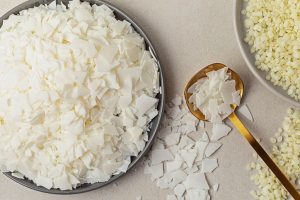What is Colored Bitumen: Properties + Differences from Black Bitumen
Colored bitumen is essentially the same as black bitumen. However, its manufacturers improve the black bitumen’s properties and performance by applying certain processes and adding chemicals to it. Therefore, colored bitumen has high flexibility, resistance, and adhesion. Additionally, it has numerous uses, the most important of which are road surfacing and construction. But how exactly is this bitumen produced? And how is it different from regular black bitumen? If you wish to know more, read this article from Iran ETrade as we explore these topics.
What is Colored Bitumen?
Combining regular bitumen with other chemicals enhances its properties and performance, which makes it suitable for more applications.
Colored bitumen is derived from the same black bitumen. But Bitumen manufacturers mix it with specific materials, including various organic and inorganic pigments.
(Click for more information on the use of soluble bitumen.) 
What is Colorless Bitumen?
Colorless bitumen has low resistance to weather changes. However, It has an advantage: Bitumen manufacturers can turn it into colored bitumen by adding just 1-2% pigment. Among colored asphalt products, one unique type is colorless bitumen. It is produced in only a few countries and is generally very costly to manufacture.
How is Colored Bitumen Produced?
The bitumen manufacturers generally produce colored asphalt by using pigments such as red and green iron oxide. If the manufacturers use colorless binders, they can create lighter-colored asphalt because these binders lack asphaltenes and have high color absorption.
The bitumen Manufacturers also produce colored bitumen by combining regular bitumen with special pigments. These pigments have two types: organic and inorganic. Organic pigments, derived from natural sources such as plants and insects, are expensive and unstable which makes them unsuitable for use in bitumen. In contrast, inorganic pigments such as red iron oxide, green chromium oxide, and titanium dioxide are highly stable and therefore, a better choice for mixing with bitumen. The type of bitumen used in this mixture (natural or industrial) is also crucial. At temperatures above 180°C, certain pigments, like yellow and black iron oxide, turn into red iron oxide. Therefore, the mixing temperature is usually kept above 180°C.
(Click for more information about Iranian bitumen exports.)
What Are Pigments in Colored Bitumen?
The pigments used in colored asphalt are also called biological pigments or biochromes. These pigments do not dissolve in water and are used as finely ground solid particles mixed with liquids.
Pigments are highly concentrated color compounds used for coloring various materials, including colored asphalt. They naturally exist in plants and animals and are produced by living organisms. Their color results from the light absorption process. Generally, pigments come in four forms: compact, powder, granular, and grout.
(Click for information on bitumen prices.)
Amount of Pigments Used
The amount of pigment needed for colored asphalt depends on the type of pigment, the quantity of bitumen produced, and the desired final color. For example, the manufacturers can easily produce red colored asphalt using red iron oxide, whereas colored bitumen like yellow and green are more difficult to produce. Therefore, bitumen manufacturers use colored aggregates alongside pigments for lighter colors in bitumen. Also for iron oxide pigments, such as black, brown, and red, manufacturers typically add between 5% to 30% of the cement’s weight to the bitumen mixture. 
Differences Between Colored Bitumen and Black Bitumen
Colored asphalt and black bitumen have significant differences. For example: Colored asphalt is more resistant to heat and cold. Additionally, due to the use of polymers, it is more durable than black bitumen. Furthermore, colored asphalt does not require painting for road construction, which reduces costs and increases the durability of the colors. On the other hand, this type of bitumen is more expensive than black bitumen due to its polymers and pigments and is more resistant to cracking and various pressures. Asphalt made with colored asphalt is also recyclable and is usually produced cold. In addition, colored asphalt is more resistant to sunlight and does not harm the environment, whereas black bitumen does not have these properties.
Best Bitumen for Producing Colored Bitumen
The best type of bitumen for producing colored bitumen is Gilsonite or natural bitumen. Gilsonite or natural bitumen has specific properties, some of which are: Easy dissolution in organic solvents, high purity, good compatibility with petroleum materials, resemblance to glass-like minerals, high water resistance, high gloss, high brittleness, and easy conversion to powder. Natural bitumen has a lower melting point (between 160 to 220°C) and good resistance to acids and bases. These properties make natural bitumen more advantageous than industrial or refined bitumen. Therefore, colored asphalt spray made from natural bitumen, named Bituclair, has better quality in terms of resistance, water repellency, durability, and longevity compared to colored asphalt produced from industrial bitumen.
(Click to learn more about the benefits of bitumen spray.)
Use of Colored Bitumen in Road Construction
Colored asphalt, due to its greater resistance to heat and cold (thanks to the use of polymers), has a major application in road construction. This property makes asphalt layers more durable and increases their lifespan. Many countries also use this type of bitumen instead of painting to mark different sections of highways, because its traits make it ideal for marking lines and paths on roads and highways.
Features of Colored Bitumen
Colored bitumen has the following features:
- High flexibility: Colored asphalt is highly compatible with chemical and petroleum materials, and polyurethane or acrylic polymer is used to increase its durability and flexibility.
- High resistance: Compared to regular bitumen, colored asphalt has a high resistance and is very practical.
- Excellent adhesion: Due to its special compounds, colored asphalt has high adhesion and good resistance to air and moisture penetration, making it an effective moisture barrier.
- High resistance to chemicals and ultraviolet rays.
- Protection of various surfaces against rust and corrosion.
- No requirement for thinning, and you can apply it to surfaces using a spray or special brush.
- Reasonably priced
- Easy to use and quick-drying

How to Use Colored Bitumen
To apply colored asphalt spray on various surfaces, you can follow these steps:
- Step 1: Before using the colored asphalt, ensure the surface is clean and dry, with no moisture, dust, grease, or contamination. Also, you should remove any loose previous paint.
- Step 2: Clean the surface using wire brushes or sandpaper. For larger surfaces, you can use sandblasting or abrasive blasting machines.
- Step 3: In humid environments, apply an anti-corrosion coating before painting the surface with bitumen.
- Step 4: Apply the paint evenly on all surfaces with the required number of layers.
How to Produce Colorless Bitumen
To produce colorless bitumen, the manufacturers refine natural or industrial bitumen by using specific processes to remove its color. Then, to enhance the bitumen’s desired properties, they usually add additives and polymers to improve its quality and strength.
Frequently Asked Questions About Colored Bitumen
Below are some of the questions that you may have about colored asphalt:
How is Colored Asphalt Produced?
Bitumen manufacturers produce colored bitumen by mixing bitumen with mineral pigments such as iron oxide or titanium dioxide.
What is the Use of Colored Bitumen in Road Construction?
Colored asphalt is used in road construction to mark different sections of roads, reduce painting costs, and increase the durability and resistance of asphalt against weather conditions.
What is the Best Bitumen for Producing Colored Bitumen?
The best bitumen for producing colored bitumen spray is natural bitumen or Gilsonite.  reference: qualitybitumen, bitumen6070 Bitumen Price
reference: qualitybitumen, bitumen6070 Bitumen Price
- The Largest Bitumen Refineries In The World: Top 20 Refineries...
- What Is An Oil Lubricant: Types, Applications + Production
- What Is LPG: Properties + Uses Liquefied Petroleum Gas
- What Is Petroleum Paraffin: Types + Properties And Applications
- What is Petroleum Coke: Types + Applications
- What Is Mazut: Advantages, Applications + Hazards









